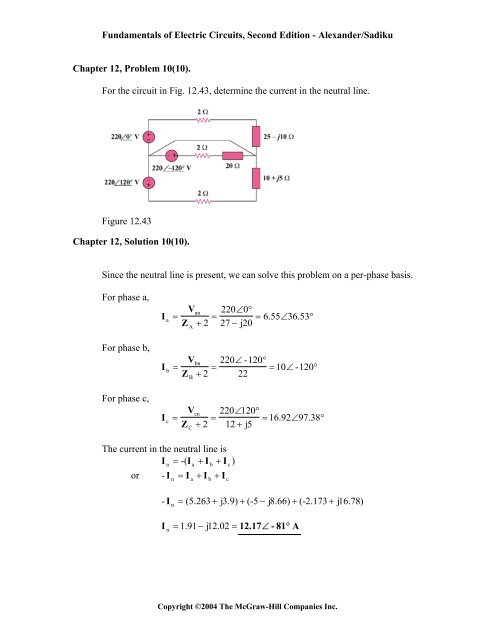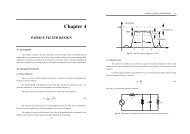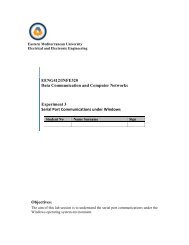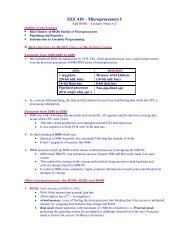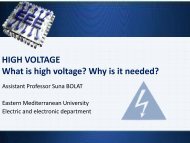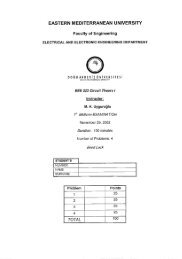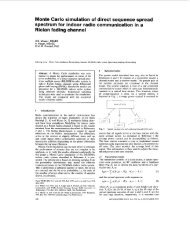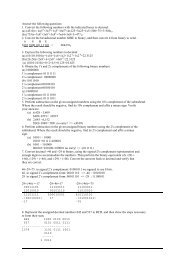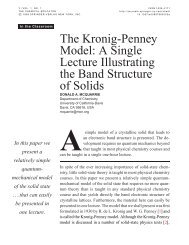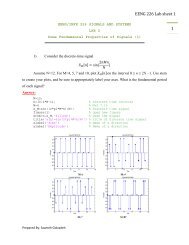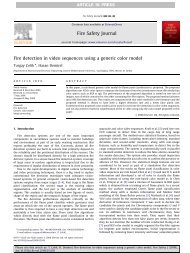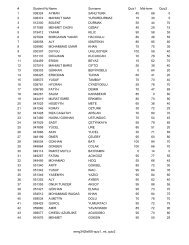Fundamentals of Electric Circuits, Second Edition ... - faraday
Fundamentals of Electric Circuits, Second Edition ... - faraday
Fundamentals of Electric Circuits, Second Edition ... - faraday
You also want an ePaper? Increase the reach of your titles
YUMPU automatically turns print PDFs into web optimized ePapers that Google loves.
<strong>Fundamentals</strong> <strong>of</strong> <strong>Electric</strong> <strong>Circuits</strong>, <strong>Second</strong> <strong>Edition</strong> - Alexander/SadikuChapter 12, Problem 10(10).For the circuit in Fig. 12.43, determine the current in the neutral line.Figure 12.43Chapter 12, Solution 10(10).Since the neutral line is present, we can solve this problem on a per-phase basis.For phase a,For phase b,For phase c,IIIabc= Van220∠0°= = 6.55∠°Z + 2 27 − j2036.53AVbn220∠-120°= == 10∠-120°Z + 2 22B= Vcn220∠120°= = 16.92∠°Z + 2 12 + j597.38CThe current in the neutral line isIn= -( Ia+ Ib+ Ic)or - I = I + I + Inabc- In= (5.263 + j3.9) + (-5 − j8.66) + (-2.173 + j16.78)In= 1.91−j12. 02 = 12 .17∠- 81°ACopyright ©2004 The McGraw-Hill Companies Inc.
<strong>Fundamentals</strong> <strong>of</strong> <strong>Electric</strong> <strong>Circuits</strong>, <strong>Second</strong> <strong>Edition</strong> - Alexander/SadikuChapter 12, Problem 12(12).Solve for the line currents in the Y-∆ circuit <strong>of</strong> Fig. 12.45. Take Z ∆ = 60∠45°Ω.Figure 12.45Chapter 12, Solution 12(12).Convert the delta-load to a Wye-load and apply per-phase analysis.110∠0° V+-I aZ YZY=Z3∆= 20∠45° ΩIa110∠0°= = 5 .5∠- 45°A20∠45°II= ∠ -120° = 5 .5∠- 165°AbI a= ∠120° = 5 .5∠75°AcI aCopyright ©2004 The McGraw-Hill Companies Inc.
<strong>Fundamentals</strong> <strong>of</strong> <strong>Electric</strong> <strong>Circuits</strong>, <strong>Second</strong> <strong>Edition</strong> - Alexander/SadikuChapter 12, Problem 22(19).Find the line currents I a , I b , and I c in the three-phase network <strong>of</strong> Fig. 12.53 below.Take Z ∆ = 12 - j15Ω, Z Y = 4 + j6 Ω, and Z l = 2 Ω.Figure 12.50Chapter 12, Solution 22(19).Convert the D-connected source to a Y-connected source.V p 208Van= ∠ - 30° = ∠ - 30° = 120∠- 30°3 3Convert the D-connected load to a Y-connected load.Z (4 + j6)(4 − j5)Z = Z ||∆Y= (4 + j6) || (4 − j5) =38 + jZ = 5.723−j0.2153Z LI aV an+-ZIa=ZVLan+ Z=120∠30°= 15 .53∠- 28.4°A7.723 − j0.2153II= ∠ -120° = 15 .53∠- 148.4°AbI a= ∠120° = 15 .53∠91.6°AcI aCopyright ©2004 The McGraw-Hill Companies Inc.
<strong>Fundamentals</strong> <strong>of</strong> <strong>Electric</strong> <strong>Circuits</strong>, <strong>Second</strong> <strong>Edition</strong> - Alexander/SadikuChapter 12, Problem 25(21).In the circuit <strong>of</strong> Fig. 12.54, if V ab = 440 ∠10°, V bc = 440∠250°,V ca = 440 ∠130° V, find the line currents.Figure 12.51Chapter 12, Solution 25(21).Convert the delta-connected source to an equivalent wye-connected source andconsider the single-phase equivalent.Ia=440∠(10° − 30°)3 ZYwhere Z = 3 + j2 + 10 − j8 = 13 − j6 = 14.32∠- 24°. 78°YIa=440∠- 20°= 17 .74∠4.78°A3 (14.32∠- 24.78°)II= ∠ -120° = 17 .74∠- 115.22°AbI a= ∠120° = 17 .74∠124.78°AcI aCopyright ©2004 The McGraw-Hill Companies Inc.
<strong>Fundamentals</strong> <strong>of</strong> <strong>Electric</strong> <strong>Circuits</strong>, <strong>Second</strong> <strong>Edition</strong> - Alexander/SadikuChapter 12, Problem 47(39).The following three parallel-connected three-phase loads are fed by a balanced threephasesource.Load 1: 250 kVA, 0.8 pf laggingLoad 2: 300 kVA, 0.95 pf leadingLoad 3: 450 kVA, unity pfIf the line voltage is 13.8 kV, calculate the line current and the power factor <strong>of</strong> the source.Assume that the line impedance is zero.Chapter 12, Solution 47(39).pf-1S= 0.8 (lagging) ⎯→θ = cos (0.8) = 36. 87°= 250∠36.87° = 200 j150 kVA1+pf-1S= 0.95 (leading) ⎯→θ = cos (0.95) = -18. 19°= 300∠-18.19° = 285 j93.65 kVA2−-1pf = 1.0 ⎯→θ = cos (1) = 0°S = 3450 kVAkVAS= 935 + j56.35 = 936.7∠3.45T= S1+ S2+ S3°ST=3 VLIL3936.7 × 10IL==33 (13.8 × 10 )39 .19A rmspf= cosθ = cos(3.45°) =0 .9982(lagging)Copyright ©2004 The McGraw-Hill Companies Inc.
<strong>Fundamentals</strong> <strong>of</strong> <strong>Electric</strong> <strong>Circuits</strong>, <strong>Second</strong> <strong>Edition</strong> - Alexander/SadikuChapter 12, Problem 81(67).A pr<strong>of</strong>essional center is supplied by a balanced three-phase source. The centerhas four plants, each a balanced three-phase load as follows:Load 1: 150 kVA at 0.8 pf leadingLoad 2: 100 kW at unity pfLoad 3: 200 kVA at 0.6 pf laggingLoad 4: 80 kW and 95 kVAR (inductive)If the line impedance is 0.02 + j0.05 Ω per phase and the line voltage at the loadsis 480 V, find the magnitude <strong>of</strong> the line voltage at the source.Chapter 12, Solution 81(67).pf = 0.8 (leading) ⎯→θ1= -36. 87°S = 150∠- 36.87 kVA1°pf = 1.0 ⎯→θ2= 0°S = 100∠0kVA2°pf = 0.6 (lagging) ⎯→θ3= 53. 13°S = 200∠53.13kVA3°S4= 80 + j95 kVAS = S1 + S2+ S3+ S4S = 420 + j165 = 451.2∠21.45°kVAS = 3 V LI L3S 451.2 × 10IL= == 542.7 A3 VL3 × 480For the line,22SL= 3ILZL= (3)(542.7) (0.02 + j0.05)SL= 17.67 + j44.18 kVAAt the source,ST= S + SL= 437.7 + j209.2ST= 485.1∠25.55°kVA3ST485.1×10VT= == 516 V3 I 3 × 542.7LCopyright ©2004 The McGraw-Hill Companies Inc.
Chapter 12, Prob. 84. Find the magnitude and phase angle <strong>of</strong> currents I a , I b , I c andI n if V = V ∠ 0 ° , V = V = 440 Volts .an p L abn Neutral∆ConnectedChapter 12, Solution 84.We first find the magnitude <strong>of</strong> the various currents.S 4000For the motor: IL= = = 5.248 A3 VL440 3Qc 1800For the capacitor: IC= = = 4.091 AVL440440PLi800For the lighting: V p= = 254 V ILi= = = 3.15 A3Vp254Consider the figure below.
a+I CI 1bV abI bI aI 2-jX CcI cI LiI 3nVabIf V an= V p∠0°, V ab= 3 V p∠30°V cn= V p∠120°IC= = 4.091∠120°-jXCVI1 = ab = 5.249 ∠ ( θ + 30 ° ) where θ = cos -1 (0.72) = 43. 95°Z∆I1= 5.249∠73.95°I2= 5.249∠- 46.05°I3= 5.249∠193.95°VcnILi= = 3.15∠120°Thus,RIa= I1+ IC= 5.249∠73.95° + 4.091∠120°Ia= 8 .608∠93.96°AI = I − I = 5.249∠- 46.05° − 4.091∠120°I = 9 .271∠- 52.16°Ab2CI = I + I = 5.249∠193.95° + 3.15∠120°I = 6 .827∠167.6°Ac3In= -ILiLiI n= 3 .15∠- 60°ARbc


